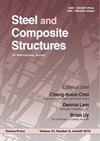拆柱事件下焊接顶板和座角连接的研究
IF 3.9
3区 工程技术
Q1 CONSTRUCTION & BUILDING TECHNOLOGY
引用次数: 0
摘要
当一个主要结构单元失效时,结构就会经历递进式倒塌,导致大部分甚至整个结构的破坏。梁柱连接是影响结构性能的主要构件之一。这些连接的不良性能和损坏可能导致局部失效,进而导致渐进式失效。在本研究中,对一些梁-柱连接的性能进行了实证和数值评估。对一些焊接的顶部和阀座角连接进行了一些试验。建立了数值模型,并通过实验验证了模型的正确性。结果表明,有限元分析结果与试验结果吻合较好。此外,利用有限元分析进行了参数化研究。研究了接触网作用的行为、失效极限状态和形成。结果表明,增加腹板或腹板角是改善连接性能的适当方法。此外,增加的角度厚度和长度的角腿附在柱可以导致更高的阻力逐步倒塌。本文章由计算机程序翻译,如有差异,请以英文原文为准。
Investigation of welded top and seat angle connections under column removal event
A structure undergoes progressive collapse when a primary structural element fails, leading to damage of either a large part or even the entire structure. Beam-column connections are one of the major contributing structural elements which significantly affect the performance of the structure. Undesirable performance and damage to these connections can result in local failure and, in turn, lead to progressive failure. In the present research, behaviors of some beam-column connections were empirically and numerically assessed subject to column removal scenario. A number of tests were performed on some welded top and seat angle connections. Then, numerical models were created and validated by the experimental results. It was observed that the results of finite element analyses very well correspond to the test results. Moreover, parametric studies were done using finite element analysis. Behavior, failure limit states, and formation of the catenary action were investigated. Results demonstrate that adding a web plate or a web angle could be an appropriate method for upgrading the connection behavior. Furthermore, an increase in the angle thickness and length of the angle leg attached to the column can result in higher resistance to progressive collapse.
求助全文
通过发布文献求助,成功后即可免费获取论文全文。
去求助
来源期刊

Steel and Composite Structures
工程技术-材料科学:复合
CiteScore
8.50
自引率
19.60%
发文量
0
审稿时长
7.5 months
期刊介绍:
Steel & Composite Structures, An International Journal, provides and excellent publication channel which reports the up-to-date research developments in the steel structures and steel-concrete composite structures, and FRP plated structures from the international steel community. The research results reported in this journal address all the aspects of theoretical and experimental research, including Buckling/Stability, Fatigue/Fracture, Fire Performance, Connections, Frames/Bridges, Plates/Shells, Composite Structural Components, Hybrid Structures, Fabrication/Maintenance, Design Codes, Dynamics/Vibrations, Nonferrous Metal Structures, Non-metalic plates, Analytical Methods.
The Journal specially wishes to bridge the gap between the theoretical developments and practical applications for the benefits of both academic researchers and practicing engineers. In this light, contributions from the practicing engineers are especially welcome.
 求助内容:
求助内容: 应助结果提醒方式:
应助结果提醒方式:


